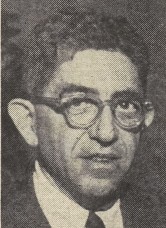Related Research Articles

Ernest Nagel was an American philosopher of science. Along with Rudolf Carnap, Hans Reichenbach, and Carl Hempel, he is sometimes seen as one of the major figures of the logical positivist movement. His 1961 book The Structure of Science is considered a foundational work in the logic of scientific explanation.
Thomas Charles Renwick Adams was a US-born Anglo-Scots illustrator and painter. Long active in a variety of visual formats, he is known for his work in book cover art, portrait painting, poster, advertising and album art. He is most widely known for his book cover art for the paperback editions of Agatha Christie.

Ulysses Simpson Grant III was a United States Army officer and planner. He was the son of Frederick Dent Grant, and the grandson of General of the Army and American President Ulysses S. Grant.
Donald William Meinig was an American geographer. He was Maxwell Research Professor Emeritus of Geography at the Maxwell School of Citizenship and Public Affairs, Syracuse University.
Sir George Grenfell-Baines was an English architect and town planner. Born in Preston, his family's humble circumstances forced him to start work at the age of fourteen. Both George and his younger brother, Richard (Dick), were prodigiously gifted mathematicians and draughtsmen. Grenfell-Baines left a secure, but limiting, job in the Lancashire County Architect's Office to work for the prestigious private firm of Bradshaw Gass & Hope in Bolton in 1930.

Henry Hicks (1837–1899) was a Welsh physician and geologist during the 19th century.

Emrys George Bowen FRGS, FSA, also known as E. G. Bowen, was an internationally renowned geographer with a particular interest in the physical geography and social geography of his native Wales. A diminutive figure, Bowen was on the academic staff of the Department of Geography and Anthropology at the University College of Wales, Aberystwyth, from the 1920s and continued to write and lecture there until his death in 1983.

Otto H. Königsberger was a German architect who worked mainly in urban development planning in Africa, Asia and Latin America, with the United Nations. He also proposed some plans for developing new cities like Bhubaneswar and Jamshedpur under the vision of Pandit Jawaharlal Nehru who wanted to build planned cities in India.
Ian Ralph Christie, was a British historian specialising in late 18th-century Britain. He spent most of his academic career at University College London (UCL), from 1948 to 1984.

Nicolas Minorsky was a Russian American control theory mathematician, engineer and applied scientist. He is best known for his theoretical analysis and first proposed application of PID controllers in the automatic steering systems for U.S. Navy ships.
John Richings "Jimmy" James OBE was a British town planner who was influential in the era following the Second World War, and was Chief Planner at the Ministry of Housing and Local Government from 1961 to 1967. It was said of him that "no-one in post-war Britain matched the range of the beneficial influences of his work" in town and country planning.
The following is a timeline of the history of the city of Ibadan, Oyo State, Nigeria.
Mark Clapson is a British social and cultural historian specialising in suburban history, the Blitz and working-class history. As of 2017, he is professor of social and cultural history at the University of Westminster.
Edward Bertram Pinniger FRES was a British recording engineer and amateur entomologist. In 1946, he and Cynthia Longfield of the Natural History Museum were the first to identify Coenagrion scitulum in Britain.
Henry Edward Merritt MBE was a British mechanical engineer who invented the Merritt–Brown triple differential tank transmission that provided greater manoeuvrability to a generation of British tanks, starting with the Churchill in 1939 and continuing into the 1980s. It allowed a tracked vehicle to change direction while on the move with less loss of power than under other steering systems, and to perform a neutral turn on the spot by rotating its tracks in opposite directions. Merritt's invention suited the faster pace of tank warfare of the Second World War, which contrasted with the more static trench warfare of the First World War, for which earlier generations of British tanks had been optimised.
Sona Rosa Burstein (1897–1971) was a museum curator, folklorist and historian of gerontology.
Udolphus Aylmer Coates, OBE FRIBA was a British town planner.

Coalbrookdale Formation, earlier known as Wenlock Shale or Wenlock Shale Formation and also referred to as Herefordshire Lagerstätte in palaeontology, is a fossil-rich deposit (Konservat-Lagerstätte) in Powys and Herefordshire at the England–Wales border in UK. It belongs to the Wenlock Series of the Silurian Period within the Homerian Age. It is known for its well-preserved fossils of various invertebrate animals many of which are in their three-dimensional structures. Some of the fossils are regarded as earliest evidences and evolutionary origin of some of the major groups of modern animals.
James Alfred Steers (1899-1987) was a prominent coastal geomorphologist who was Professor of Geography at the University of Cambridge from 1949 to 1966.
The Ministry of Town and Country Planning was a ministry established in 1943 by the Churchill war ministry, the government of the United Kingdom at the time. Its remit covered England and Wales. It was established to secure "consistency and continuity in the framing and execution of a national policy with respect to the use and development of land throughout England and Wales". The first minister was William Morrison, previously the Postmaster General.
References
- 1 2 Wise, Michael (2000). "Dr E.C 'Christie' Willatts, OBE 1908-2000: An obituary". Geography. 85 (2): 166–166. ISSN 0016-7487.
- ↑ Steers, J. A. (1944). "Coastal Preservation and Planning". The Geographical Journal. 104 (1/2): 7–18. doi:10.2307/1790025. ISSN 0016-7398.